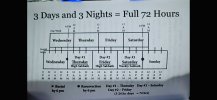A spanner in the works is that the present Jewish calendar has a floating passover Sabbath so would work for the first proposal above, which requires two sabbaths in one week.
Yes, it must. I had always interpreted the text as meaning that the Passover was a sabbath, one day, then the feast of unleavened bread occurred, and on the seventh day at the end of the feast was a second sabbath, also one day long. But I see on closer inspection that the text may mean the first day of the feast itself is a sabbath also, making two sabbaths in a row as in your chart. Not sure which is more correct.
I see the confusion, but it is slightly different.
The first day of the Feast of Unleavened Bread itself (i.e., Thursday of THAT week) is a "High Holy Day" (no regular work) and that follows the Seder ('Passover meal') itself "between the evenings."
The day of First Fruits is the day AFTER the regular weekly Sabbath that week, which would have been 'sunday' that week, and (by my reading which you now see) is
always on a sunday. In fact, it often coincides (but not this year by most reckonings) with the 'Resurrection Day' observations. Since it is, thus, First Fruits, and He was the focus as that, I have no problem with the dating.
The 'fifty-day countdown' thus begins on the sunday after Passover. Which means Shavuot also always falls on the first day of the week.
But it does lead to two important points. Rashi, among others, but prominently, reads the
"day after the Sabbath," in the text to mean the day after the 'high holy day' of that week, as opposed to the regular weekly Sabbath. (I think he got that wrong, and the reason might well be that conflict with the RCC. Elsewhere, he/they are careful to distinguish between a weekly Sabbath, and the
moed, or High Day, specified by YHVH.)
Which leads to the second point. "First Fruits," while a Biblical 'set-apart day' of YHVH is NOT specified as a day of "no work." Nor is it identified specifically as one of the three "Feasts of Ascension" (where all the men would return to, essentially, Jerusalem; Pesach, Shavuot, Sukkot.) Although likely most would still be there, anyway.
Oh, one more note: Because of 'calendar confusion' over the centuries, and the Diaspora (scattering, across time zones, etc) the Hillel, or Rabbinic, or Diaspora Calendar (commonly used, seen on published calendars) calculates dates for the Feasts. But most "traditional jews" I know then celebrate the major High Holy Days (especially Pesach) by doing them for TWO days in a row, just to make sure not to miss it...


